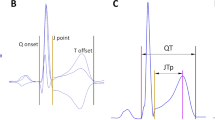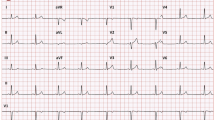Summary
The growth of knowledge of the QT interval of the ECG is reviewed. 1980 was the centennial of the first careful measurements of Burdon-Sanderson and Page, and also the 60th anniversary of Bazett's contribution that established a predictable relation of the QT to heart rate in normal subjects.
The waxing and waning of interest in the QT among clinical cardiologists appear to have been related to a low sensitivity and specificity of abnormal QT/rate ratios in many clinical diseases. The QT duration has been established as a valuable measurement, and sometimes the patterns may be nearly pathognomonic of electrolyte disturbances. Alterations from a predicted normal mean may give a clue to disease.
The importance of transient dissociation of the predicted QT from the measured QT with rapid changes in heart rate deserves further emphasis. In the publication of data on the duration of QT, the reporting only of the corrected QT (QTc), the index of Bazett, conveys an incomplete picture of the nature of the changes.
The prolonged QT pattern in adults should be suspected of being related to drugs first, except when a neurogenic cause is apparent. The idiopathic hereditary syndrome still defies a completely adequate explanation, though neurogenic influences are overtly important. No universal management has been established.
Similar content being viewed by others
References
Abildskov JA (1976) Adrenergic effects on the QT interval of the electrocardiogram.Am Heart J 92:210–216
Abildskov JA, Evans AK, Lux RL, Burgess MJ (1980) Ventricular recovery properties and QRST deflection area in cardiac electrograms.Am J Physiol 239:227H-231H
Alimurung MM, Joseph LB, Craige E, Massell BG (1950) The QT interval in normal infants and children.Circulation 1:1329–1337
Ashman R (1942) The normal duration of the QT interval.Am Heart J 23:522–534
Bashour T, Jokhadar M, Cheng TO (1981) Effective management of the long QT syndrome with amiodarone.Chest 79:704–706
Baudouy PH, Andreassian B, Attuel P, Greze M, Soulie J, Fruchard J (1977) Syndrome de Romano-Ward et stellectomie gauche: Revue generale a propose d'un noveau cas.Arch Mal Coeur 70:645–652
Bazett HC (1920) An analysis of the time relations of electrocardiograms.Heart 7:353–370
Bristow MR, Schwartz HD, Binetti G, Harrison DC, Daniels JR: Ionized calcium and the heart (1977) Elucidation of in vivo concentration response relationships in open chest dogs.Circ Res 41:565–574
Brown JM, Yetter JF, Spicer MJ, Jones JD (1978) Cardiac complications of protein-sparing modified fasting.JAMA 240:120–122
Burchell HB, Merideth J (1969) Management of tachyarrhythmias with cardiac pacemaker, in Furman S (ed):Advances in Cardiac Pacemakers. Ann NY Acad Sci 167:546–556
Burchell HB, Pruitt RD, Barnes AR (1948) The stress and the electrocardiogram in the induced hypoxemia test for coronary insufficiency.Am Heart J 36:373–389
Burdon-Sanderson J, Page FJM (1880) On the time relations of the excitatory process in the ventricle of the heart of the frog.J Physiol 2:384–435
Chatterjee K, Harris A, Davies G, Leatham A (1969) Electrocardiographic changes subsequent to artificial ventricular depolarization.Br Heart J 31:770–779
Chaudron JM, Lebacq EG (1980) Romano-Ward syndrome treated by left stellectomy and intracavity stimulation.Am Heart J 100:131–133
Coraboeuf E, Weidmann S (1949) Potentiel de repos et potentiels d'action du muscle cardiaque, mesures a d'aide de'electrodes internes.Compt Rendus Seances Soc Biol 143:1329–1331
Crampton RS (1978) Another link between the left stellate ganglion and the long QT syndrome.Am Heart J 96:130–132
Crampton RS: Stellate ganglion block and stimulation in long QT syndrome, sympathetic dystrophy of the arm, and normal, in Schwartz PS, Brown AM, Malliani A, Zanchetti A (eds):Neural Mechanisms in Cardiac Arrhythmias. New York, Raven Press, 1978, vol 2, pp 55–73
Curtis EI, Heibel RH, Shaver JA (1978) Autonomic maneuvers in hereditary QT interval prolongation (Romano-Ward syndrome).Am Heart J 95:420–430
Davignon A, Rautaharju P, Boisselle E, Soumis F, Megelas M, Choquette A (1978–1980) Normal ECG standards for infants and children.Ped Cardiol 1:123–131
DeLalla V, Brown HR (1950) The normal respiratory variation of cycle length QT interval and corrected QT interval of the electrocardiogram.Am Heart J 39:519–522
DeSilvey DL, Moss AJ (1980) Primidone in the treatment of long QT syndrome: QT shortening and ventricular arrhythmia suppression.Ann Intern Med 93:53–54
Doherty JA, Hara M (1961) The effect of citrate infusion on the electrocardiogram of the hypothermic and normothermic dog.Am Heart J 61:225–235
Fingl E, Woodbury LA, Hecht HH (1952) Effect of innervation and drugs upon direct membrane potentials of embryonic chick myocardium.J Pharmacol Exp Ther 104:103–114
Fisher JD (1979) The normal QT during exercise, abstracted.Circulation 59–60(suppl 2):256
Fowler NO, McCall D, Chou T, Homes JC, Hanenson IB (1976) Electrocardiographic changes and cardiac arrhythmias in patients receiving psychotropic drugs.Am J Cardiol 37:223–230
Frick W: Relative QT, Dauer bei der respiratorischen Arrhythmia des Hundes.Z Kreislaufforch 31:349–355, 1939
Gavrilescu S, Luca C (1978) Right ventricular monophasic action potentials in patients with long QT syndrome.Br Heart J 40:1014–1018
Hafkesbring EM, Drawe CE, Ashman R (1939) Children's electrocardiograms.Am J Dis Child 53:1457–1469
Hancock EW, Cohn K (1966) The syndrome associated with midsystolic click and late systolic murmur.Am J Med 41:183–196
Hartzler G, Osborn MH (1981) Invasive electrophysiologic study in the Jervell and Lange-Nielsen syndrome.Br Heart J 45:225–229
Heissenbuttel RH, Bigger JT (1970) The effect of oral quinidine on intraventricular condition in man: Correlation of plasma quinidine with changes in the QRS duration.Am Heart J 80:433–462
Hiejema K, Suzuke F, Satake S, Ishihara K (1981) Electrophysiologic studies of Jervell, Lange Nielsen syndrome.Chest 79:446–448
Horowitz O, Graybiel A (1948) Prolongation of the QT interval in the electrocardiogram occurring as a temporary functional disturbance in healthy persons.Am Heart J 35:480–484
Jacob AL, Hope RR (1979) Prolongation of the QT interval in lithium toxicity.J Electrocardiol 12:117–119
Jacobson D, Schrire V (1966) Giant T wave inversion.Br Heart J 28:768–775
James TN, Groggatt P, Atkinson WJ, Lurie PL, McNamara DE, Miller WW, Schloss GT, Carroll JF, North RL (1978) DeSubitaneis Mortibus XXX: Observations on the pathophysiology of the long QT syndromes with special reference to the neuropathology of the heart.Circulation 57:1221–1231
Jervell A, Lange-Nielson F (1957) Congenital deaf mutism, functional heart disease with prolongation of the Q-T interval, and sudden death.Am Heart J 54:59–68
Keys A, Brozek J, Henschel A, Mickelson O, Taylor HL:Biology of Human Starvation. Minneapolis, University of Minnesota Press, 1950, pp 646–647
Klakeg C, Berry AM, Burchell HB (1954) Duration of QT interval at slow ventricular rates.Am J Physiol 179:159–164
Klakeg C, Pruitt RD, Burchell HB (1955) A study of electrocardiograms recorded during exercise tests on subjects in the fasting state and after ingestion of a heavy meal.Am Heart J 49:614–625
Kumancik WM, Denlinger JK, Nahrwold ML, Falk RB (1978) The QT interval and serum ionized calcium.JAMA 240:366–368
Kuo CS, Surawicz B (1976) Ventricular monophasic action potential changes associated with neurogenic T wave abnormalities and isoproterenol administration in dogs.Am J Cardiol 38:170–177
Lepeschkin E, Surawicz B (1953) The duration of the QU interval and its components in the electrocardiograms of normal persons.Am Heart J 46:9–20
Loeb HS, Pietra RS, Gunnar RM, Tobin JF (1968) Paroxysmal ventricular fibrillation in two patients with hypomagnesemia.Circulation 37:210–215
Lown B: Cardiovascular collapse and sudden cardiac death,in Braunwald E (ed):Heart Disease. Philadelphia, WB Saunders Co, 1980, p 788
McCammon RW: A longitudinal study of electrocardiographic intervals in healthy children.Acta Pediatr Scand Suppl, 1961, p 126
Manion CV, Whitsett TL, Wilson MF (1980) Applicability of correcting the QT interval for heart rate.Am Heart J 99:678
Mason JW, Winkle RA, Rider AK, Stinson ED, Harrison DC (1977) The electrophysiologic effects of quinidine in the transplanted human heart.J Clin Invest 59:481–489
Milne JR, Camm HA, Ward DE, Spurrell RAJ (1980) Effect of intravenous propranolol.Br Heart J 43:1–6
Mitchell JH, Shapiro AP (1954) The relationship of adrenalin and T wave changes on the anxiety state.Am Heart J 48:323–330
Moss AJ, McDonald J (1971) Unilateral cervicothoracic sympathetic ganglionectomy for treatment of long QT interval syndrome.N Engl J Med 285:903–904
Murayama M, Mashima S, Shimura K, Takayanagi K, Tseng YZ, Murao S (1981) An experimental mode of giant negative T wave associated with QT prolongation produced by combined effect of calcium and isoproterenol.Jpn Heart J 22:257–265
Navarro-Lopez, Cinca J, Sanz G, Periz A, Magrina J, Betriv A (1978) Isolated T wave alternans.Am Heart J 95:369–374
Newton M (1949) Electrocardiographic changes on tilting.Am Heart J 37:1090–1100
Osborn JJ (1953) Experimental hypothermia—respiratory and blood pH changes in relation to cardiac function.Am J Physiol 175:389–398
Perkins CM (1978) Serious verapamil poisoning: Treatment with intravenous calcium gluconate.Br Med J 2:1127
Ratshin RA, Hunt D, Russell RO, Rackley CE (1971) QT interval prolongation, paroxysmal ventricular arrhythmias and convulsive syncope.Ann Intern Med 75:919–924
Rickards AF, Norma J (1981) Relation between QT interval and heart rate: New design of physiologically adaptive pacemaker.Br Heart J 45:56–51
Rubin SA, Brudage B, Mayer W, Chatterjee K (1979) Usefulness of Valsalva manoeuvre and cold pressure for evaluation of arrhythmias in long QT syndrome.Br Heart J 42:490–492
Schlamotitz I (1947) Analysis of the time relations within the cardiac cycle in electrocardiograms of normal QT: IV. The effect of position change on the relations of the QT and TP intervals respectively to the cycle length.Am Heart J 34:702–708
Schoonmaker FW, Osteen RT, Greenfield JC (1966) Thioridazine (Mellaril)-induced ventricular tachycardia controlled with an artificial pacemaker.Ann Intern Med 65:1076–1078
Schwartz PJ, Malliani A (1975) Electric alternans of the T wave: Clinical and experimental evidence of its relationship to the sympathetic nervous system and the long QT interval.Am Heart J 89:45–50
Schwartz PS, Stone HL: Unilateral stellectomy and sudden death, in Schwartz PJ, Brown AM, Malliani A, Zanchetti A (eds):Neural Mechanisms in Cardiac Arrhythmias. New York, Raven Press, 1978, vol 2, pp 107–122
Simonson E, Cady LG, Woodbury M (1962) The normal QT interval.Am Heart J 63:747–753
Singh BM, Gaarder TD, Kanegae T, Goldstein M, Montomerie JZ, Mills H (1978) Liquid protein diets and torsade de pointes.JAMA 240:115–119
Steinbrecher UP, Fitchett DH (1980) torsade de pointes: A case of syncope with atrioventricular block.Arch Intern Med 140:1223–1226
Surawicz B (1967) Relationship between electrocardiogram and electrolytes.Am Heart J 73:814–831
Surawicz B, Gettes LS (1963) Two mechanisms of cardiac arrest produced by potassium.Circ Res 12:415–421
Susmano A, Graettinger JS, Carleton RA (1969) The relationship between Q-T interval and heart rate.J Electrocardiol 2:269–274
Taylor GJ, Crampton RS, Gibson RS, Stebbins PT, Waldman MTG, Beller GA (1981) Prolonged QT interval at onset of acute myocardial infarction in predicting early phase ventricular tachycardia.Am Heart J 102:16–22
Thurston J, Marko P (1974) Electrocardiographic changes in anorexia nervosa.Br Heart J 36:719–723
Vaughn Williams EM, Hassan MO, Floras JS, Sleight P, Jones JV (1980) Adaptation of hypertensives to treatment with cardioselective and non-selective beta blockers: Absence of correlation between bradycardia and blood pressure control, and reduction in the slope of the QT/RR relation.Br Heart J 44:473–487
Vincent GM, Abilsokov JA (1977) The Romano-Ward (prolonged QT) syndrome, abstracted.Circulation 55–60(suppl 3):156
Vincent GM, Abildskov JA, Burgess MJ (1974) QT interval syndromes.Prog Cardiovasc Dis 16:523–520
Wallace AG, Cline RE, Sealy WC, Young WG, Troyer WG (1966) Electrophysiologic effects of quinidine studies using chronically implanted electrodes in awake dogs with and without cardiac denervation.Circ Res 19:960–969
Weaver WF, Burchell HB (1960) Serum potassium and the electrocardiogram in hypokalemia.Circulation 21:505–521
Wellens JHH, Vermeulen A, Durrer D (1972) Ventricular fibrillation occurring on arousal from sleep by auditory stimuli.Circulation 46:661–665
White PD, Mudd SG (1929) Observation on the effect of various factors on the duration of electrical systole on the heart as indicated by the length of the QT interval of the electrocardiogram.J Clin Invest 7:387–435
Wilson FN (1931) The T deflection of the electrocardiogram.Trans Assoc Am Phys 46:29–51
Wortsman J, Frank S (1981) The QT interval in clinical hypercalcemia.Clin Cardiol 4:87–90
Yanowitz F, Preston JB, Abildskov JA (1966) Functional distribution of right and left stellate innervation to the ventricles: Production of neurogenic electrocardiographic changes by unilateral alteration of sympathetic tone.Circ Res 18:416–428
Yu PNH, Bruce RA, Lovejoy FW, Pearson R (1950) Observations on the change of ventricular systole (QT interval) during exercise.J Clin Invest 29:281–289A0946014 00010 CS-SPJRNPDF [HEADSUP]
Author information
Authors and Affiliations
Additional information
This article is based on a presentation at theRay C. Anderson Symposium.
Rights and permissions
About this article
Cite this article
Burchell, H.B. The QT interval historically treated. Pediatr Cardiol 4, 139–148 (1983). https://doi.org/10.1007/BF02076339
Issue Date:
DOI: https://doi.org/10.1007/BF02076339




